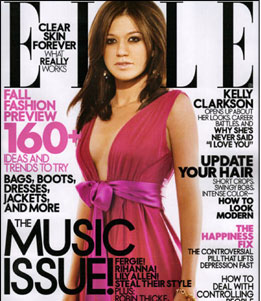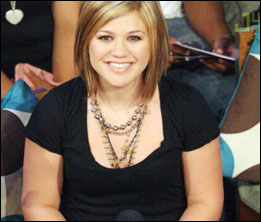|
|
| |
instep
comment
Whittle
me pretty! The new age art of air brushing reality
Humanity is not enough any more. In this visual age, photos must
be picture perfect. Glamour taken to the max has taken precedence
over being comfortable with who we really are. It's a global phenomenon
and it's arrived in Pakistan too. Fashion is not just about make
up any more, it owes a lot more to Photoshop.
By
Sonya Rehman |
| |
Walk
into any bookstore and the first thing to catch your eye would most
probably be the display rack of thick, glossy, glamour magazines.
So you pick one up and skim through it, soaking in its fun, trashy
content. And then you come across a series of photo shoots, some of
which are brilliantly executed. But then you furrow your brow and
bite your lip, tilting your head a little for further inspection.
What's probably caught your eye is the model being featured in the
spreads for a designer's new collection. "She's actually quite
dark in real life," you'd murmur, ruminating, "but here
her skin looks as white and as smooth as alabaster."
But that's just the tip of the iceberg. Chances are the model's anatomy
would be airbrushed to high heavens – so much so that she looks
almost unrecognizable, and then at second glance you'll acknowledge:
'oh yeah, wait a minute that's…her'?!
|
 |
| |
Airbrushing
magazine covers and photoshoots have been done for decades, and sadly
this 'obsession' for perfection has wound up giving women just one
cold, dark message: that no matter what you do, you'll always be physically
unfit and unworthy.
International magazines such as Vogue, Sixteen, GQ, Harper's Bazaar
and others have for years resorted to pinching waists, tucking lumps,
elongating legs, enlarging eyes, and reducing size - and unfortunately
Pakistani fashion publications, seem to have too, jumped this horrendously
plastic, look-ma-I'm-perfect, bandwagon.
Today, if you ask any model and/or 'celebrity': "Bibijee, aap
ki khoosurati ka kya raaz hay"? You can almost expect them to
flutter their lashes, chuckle and say: "Photoshop, aur kya?"
|
| |
| "Airbrushing
in Pakistan happens to a large extent most definitely," Rizwan
(of Deeves) states. "But Pakistani models in general are very
skinny so such severe airbrushing isn't really required. The only
time we may have to resort to airbrushing is probably when it comes
to our local film stars. Look at our models such as Neha and Misha
– they don't need to be cut…but it still happens, both
locally and internationally where the models will have smaller jaw
lines and waists. Of course it makes women insecure about their looks,
but at Deeves we only touch-up a model's face by enhancing it and
that's it – in foreign magazines you can actually see the model's
skin pores on the front cover, but here in Pakistan, the model's skin
looks so unblemished and so doll-like," Rizwan enunciates with
a tinge of disgust before proceeding, "that the skin texture
is totally absent." |
 |
| |
| Just
the other day, I came across an edition of Elle which featured such
a thoroughly emaciated Kelly Clarkson in a plum-coloured drape dress,
that I felt myself being reduced to Edvard Munch's human version of
The Scream. "Buss karo, buss karo!", I imagined the buxom
Clarkson to be yelling as the graphic artist clicked away on his mouse
and sliced off her square jaw, and nipped her healthy waist down to
a painful 24. |
| |
"The
airbrush was a diabolical invention. I'll look at a photo and say,
'God, I wish I still looked like that.' Then I realize, 'Oh, I never
did.' I long to see actresses as they really are, with wrinkles and
blemishes," American actress, Kate Beckinsale, had stated candidly
in an interview.
While some of us are 'evolved' enough to mentally toss aside pinching
insecurities - after a quick flip-through of a fashion spread –
and rationalize within, a majority of the rest of us will eventually
wind up being afflicted by the super perfect models, women and celebrities
that we see in these very rag-mags.
But are these supermodels really all that 'super'? Superbly-photoshopped
rather! |
 |
| |
| "Airbrushing
distorts the way beauty is perceived", styling and make-up virtuoso
Tariq Amin states, "I absolutely hate Photoshop and I'm just
not interested in that type of 'photography'. Airbrushing is a complete
misinterpretation of reality and a social injustice because it creates
terribly poor self-esteem for young girls. Look, I've always been
a naturalist when it comes to my work – but elongating necks,
plumping mouths and sculpting the body…good heavens it just
doesn't stop! This concept of 'beauty' is totally cosmetic –
I mean these days, you actually have local stylists suggesting botox
and nose jobs! I know of many young models that've been approached
by XYZ suggesting lipo injections in the face…it's all so demoralizing
for young girls." |
| |
| "There
are two types of photographers," Aaminah Haq – one of the
country's most well-recognized and unconventional models – says;
"one is a graphic artist who uses the photograph as a canvas,
and the other photographer is the one who is not going to make his/her
captured image make me look like I have a 14-inch waist. Ten years
ago, the photographers in Pakistan worked on transparencies, there
was no levy for correction… but now I believe there are many
photographers who use their captured images as canvases. International
magazines will depict things such as Madonna on the cover of Cosmopolitan
with enhanced cheekbones, stretched eyes and a heavier chest –
and in comparison to the way things are airbrushed abroad, locally,
we're like a teddy bear's picnic! For a decade I was told that I had
to compete with girls aged 16, all of whom had tiny waists and twig-like
arms. But now my theory is: I don't want to be anorexic. I want to
be athletic. I get depressed when I see magazines like Vogue and sure
it makes me feel bad about my image, but I would prefer looking fit
and healthy at 50, rather than looking like last night's leftovers!" |
 |
| |
Is fashion really all about deception, lies and Photoshop? What's
scary about this whole airbrushing trend is that from a sociological
perspective, it resorts in a pattern of deeply embedded discontented
thought, which makes individuals – both men and women- unhappy
with anything that they perceive to be less than 'perfect'.
It's this whole vicious cycle of: 'But I'm not good enough, I simply
don't feel physically appealing enough', that results in the gradual
breakdown of a person's self-worth, in addition to high expectations
(regarding one's physical appearance and that of others), along
with judging each other simply on the basis of the exterior make-up.
And that is what's truly disturbing.
|
| |
|

